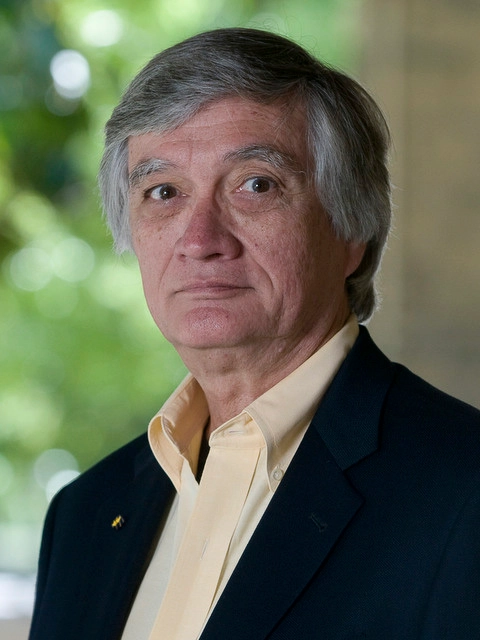
Rod Ewing led a three-year study recommending changes to the U.S. nuclear waste management program. (Image credit: Courtesy CISAC)
The U.S. government has worked for decades and spent tens of billions of dollars in search of a permanent resting place for the nation’s nuclear waste. Some 80,000 tons of highly radioactive spent fuel from commercial nuclear power plants and millions of gallons of high-level nuclear waste from defense programs are stored in pools, dry casks and large tanks at more than 75 sites throughout the country.
A Stanford University-led study recommends that the United States reset its nuclear waste program by moving responsibility for commercially generated, used nuclear fuel away from the federal government and into the hands of an independent, nonprofit, utility-owned and -funded nuclear waste management organization.
“No single group, institution or governmental organization is incentivized to find a solution,” said Rod Ewing, co-director of Stanford’s Center for International Security and Cooperation and a professor of geological sciences.
The three-year study, led by Ewing, makes a series of recommendations focused on the back-end of the nuclear fuel cycle. The report, Reset of America’s Nuclear Waste Management Strategy and Policy, was released today.
A tightening knot
Over the past four decades, the U.S. nuclear waste program has suffered from continuing changes to the original Nuclear Waste Policy Act, a slow-to-develop and changing regulatory framework. Erratic funding, significant changes in policy with changing administrations, conflicting policies from Congress and the executive branch and – most important – inadequate public engagement have also blocked any progress.
Go to the web site to view the video.
“The U.S. program is in an ever-tightening Gordian knot – the strands of which are technical, logistical, regulatory, legal, financial, social and political – all caught in a web of agreements with states and communities, regulations, court rulings and the congressional budgetary process,” the report says.
The project’s steering committee sought to untangle these technical, administrative and public barriers so that critical issues could be identified and overcome. They held five open meetings with some 75 internationally recognized experts, government officials, leaders of nongovernmental organizations, affected citizens and Stanford scholars as speakers.
After describing the Sisyphean history of the U.S. nuclear waste management and disposal program, the report makes recommendations all focused around a final goal: long-term disposal of highly radioactive waste in a mined, geologic repository.
“Most importantly, the United States has taken its eyes off the prize, that is, disposal of highly radioactive nuclear waste in a deep-mined geologic repository,” said Allison Macfarlane, a member of the steering committee and a professor of public policy and international affairs at George Washington University. “Spent nuclear fuel stored above ground – either in pools or dry casks – is not a solution. These facilities will eventually degrade. And, if not monitored and cared for, they will contaminate our environment.”

Current Storage Sites for High-Level Radioactive Waste and Spent Nuclear Fuel and Repository with License under Review (Image credit: Department of Energy)
Not a new idea abroad
The new, independent, utility-owned organization would control spent fuel from the time it is removed from reactors until its final disposal in a geologic repository. This is not a new idea. Finland, Sweden, Switzerland and Canada all have adopted a similar approach – and their nuclear waste management programs are moving forward. Finland expects to receive its first spent fuel at its geologic repository on the island of Olkiluoto in the mid-2020s.
“Initially, I was skeptical about placing utilities with nuclear power plants in control of the spent fuel from commercial reactors,” said Ewing. “But as we discussed the advantages of this cradle-to-grave approach, I was persuaded, particularly because this is the approach taken by other successful programs.”
Essential to the success of a new organization would be access to the Nuclear Waste Fund. Reassigning responsibility to a new organization – whether controlled by the federal government or nuclear utilities – would require an act of Congress. The report recommends that the Nuclear Waste Fund, more than $40 billion, be transferred to the new organization over several decades. If the new organization successfully develops a geologic repository, this repository could also be used for highly radioactive defense waste.
“The status quo is a big liability for the future of nuclear power, an established source of carbon-free electricity,” said Sally Benson, co-director of Stanford’s Precourt Institute for Energy and a member of the report’s steering committee. “These recommendations will, I hope, break the gridlock in Washington and prompt concrete action to solve this problem.”
To read all stories about Stanford science, subscribe to the biweekly Stanford Science Digest.
Benson is also a professor of energy resources engineering. She and Ewing are members of Stanford’s School of Earth, Energy & Environmental Sciences.
The Reset of America’s Nuclear Waste Management project was funded by the Precourt Institute for Energy, the Freeman Spogli Institute for International Studies and the Center for International Security and Cooperation. The meetings at George Washington University were supported by the John D. & Catherine T. MacArthur Foundation.
Media Contacts
Kathleen Gabel Chui, Center for International Security and Cooperation: (650) 725-6488, kgabel@stanford.edu